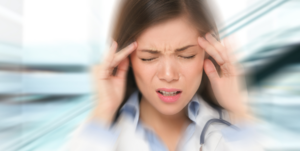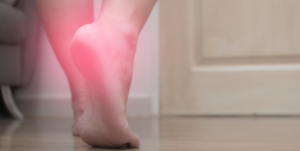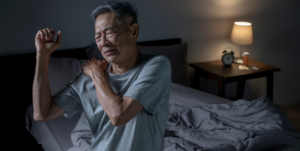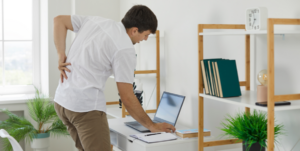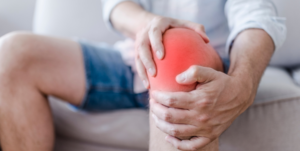Whether you are at your office desk working for hours or playing your favourite video game till 3am, sitting down for too long brings about a slew of negative effects, with back pain being one of them. Thankfully, back pain, if not serious, can be treated without expensive or invasive procedures. In fact, the TCM approach alone offers various natural options from acupuncture to herbal medicine with a holistic benefit to your health. Combined with some simple lifestyle changes, you can bid farewell to your back pain! . Read on to explore the TCM approach and other lifestyle tips to ease your suffering!
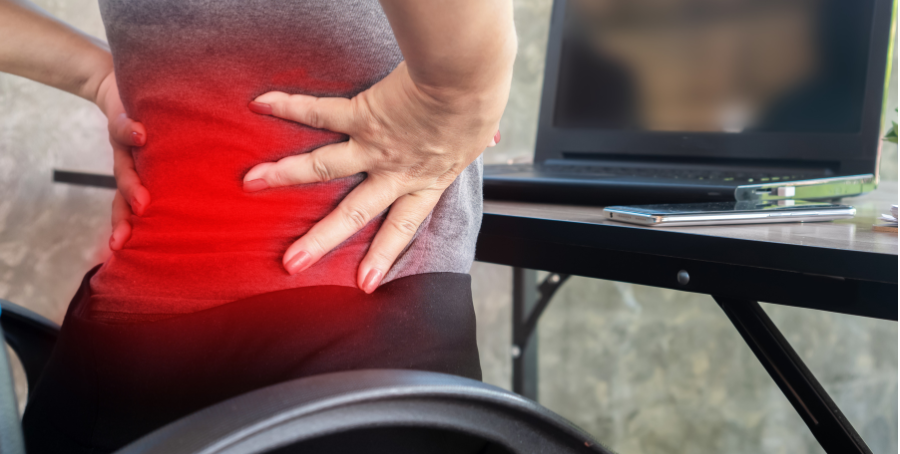
What are the causes of lower back pain when sitting?
Lower back pain happens when any part of the lower back is not functioning optimally. This could be the spine, the muscles, the fascia, organs, and more. Lower back pain occurs for a variety of reasons, from poor lifestyle habits to a more serious underlying medical condition.
Sitting for long hours without moving around reduces the blood circulation to the lower back and potentially lead to qi blockages in the meridians, resulting in tight muscles and pain. Beyond that, the discs, which are cushioning layers between the vertebrates, are placed under constant pressure, increasing the risk of wear and tear.
Posture is another vital determinant of back pain. Sitting cross-legged can create a misalignment between the pelvis and the spine, giving chronic back pain. Slouching overstretches the spinal ligaments and place more pressure on your spine and lower back. In combination, a weak core from lack of exercise means that muscles in your abdomen, sides, and back cannot protect or support the spine properly, leaving you more vulnerable to injuries.
In TCM, the above poor lifestyle habits lead to a lack of Qi and blood flow, which is responsible for pain sensation. A lack of Qi can be attributed to either Qi deficiency or Qi stagnation. A weakened Qi can be from internal and external factors. External factors include exposure to the wind, cold, or dampness (humid or rainy weather), which is indicated by a flaring in pain during colder weather. Meanwhile, internal factors include a generalized weak constitution, overwork, poor diet, and stress which presents themselves as Qi, Yin, and/or Yang deficiency:
- Qi deficiency: Caused by a poor diet with insufficient nutrients to nourish the Qi. Overactive lifestyle like overexercise or a sedentary lifestyle can deplete the Qi reserves. For older people, the gradual depletion of kidney Qi from old age could lead to a dull and lingering ache in the lower back that may worsen overtime.
- Yin deficiency: Attributed to stress, poor sleep, and/or frequent intercourse or masturbation.
What are some tips and lifestyle changes to reduce back pain while sitting?
If you are looking to relieve your lower back pain, some treatment to consider are:
Heat therapy
Many a time the cold makes the pain worse, but heat can increase blood flow to the affected area, which reduces inflammation, promote healing, and relax stiff muscles which all help with pain relief. You can place a heating pad or warm water bottle/towel on your lower back while lying down or behind the chair if you’re sitting. Do note that this is more suitable for those without any redness or swelling at the area.
Herbs
Herbs are natural ingredients to address health issues and restore balance and harmony in the body. Herbs can be combined based on the individual’s unique constitution to optimize the therapeutic effect. Try out some of these herbs to resolve the root causes of your back pain:
- 杜仲 Eucommia: Treat Liver and Kidney deficiency (which contributes to lower back pain) and strengthen the endocrine system. This is more suited for people who are older and involved in physically demanding work, or those who work under air-conditioning for long hours.
- 胡桃仁/核桃仁 Walnut: Aids in lower back pain by warming the kidney and nourishing the Qi. Get them in a bag or jar and munch on them as a snack! It has various other health benefits as well such as relieving constipation and lowering blood pressure.
- 冬虫夏草 Cordyceps: This is particularly effective for people with weaker constitutions after having just recovered from an illness and is experiencing lower back pain.
Acupressure
In TCM, stimulating specific acupoints on your body helps to remove Qi blockages and resolve Qi deficiency or stagnation that is causing pain. To increase Qi flow to the lower back, some useful acupoints are:
Lumbar Pain Point (腰痛点)
Put your hand on a flat surface and lift your fingers. You should see the raised metacarpal bones. Massage the area between the second and third bones (index and middle fingers), as well as between the fourth and fifth bones (ring and pinky finger). This is more useful for those with acute lower back pain.
Wei Zhong (委中)
Located at the back of the knee. Massage the position with your fingers for 2 to 5 minutes. It helps relieve pain that is on either side of the back that flows down to the legs.
Shen Shu (肾俞)
On the lower back, 2 inches below the waist on either side of the spine (approx. 2 fingers’ width away from the middle of the spine).
Massage these acupoints at home for pain relief and reinvigorate the Qi. For a more extensive and long-lasting treatment, you can also try out acupuncture at Singapore Paincare TCM Wellness, a process involving the insertion of thin needles into specific points of the body to invigorate and improve Qi flow. With our physicians’ expertise, they will create a customised treatment plan that addresses the root causes of your back pain and improve your overall health.
How to prevent lower back pain when sitting?
Of course, prevention is better than treatment. Seeking professional services is futile if you are not willing to make permanent lifestyle changes to avoid back pain. But if you are, you can try out some of these tips below:
Better Posture:
To minimize additional pressure on the lower back muscles and re-establish Qi flow, be more conscious of your posture when sitting. To straighten your posture, place your fingers just above your head and have your head attempt to touch your fingers. This helps to keep your head and neck in line with your torso. If possible, keep your monitor at eye level to avoid neck pain as well. Avoid slouching, slumping to one side of the body, crossing your legs, or having your legs dangling.
If your work requires you to spend long hours sitting, consider investing in a good ergonomic chair, or lumbar support cushion for your seat. It supports the natural ‘S’ shape of the spine to prevent slumping, reducing strain on the spine and pelvis.
Take a break and stretch!
Stretch and move around for a few minutes! It makes a huge difference in breaking that static posture and improving the blood circulation to any stiff muscles. It can help you focus better and improve productivity! Some stretches include twisting your body left and right or having reminders to walk to the washroom/pantry once every hour.
If you are working from home or feel stiff after work, more extensive stretches like cat-cow position and hugging the knees to the chest would loosen any stiff muscles before you go to bed.
Strengthen your core
The core is the central part of the body that controls the pelvis and protects the spine. A strong core is more than just a 6-pack or a 11-line abs – it consists of the back, abdominal, and pelvic muscles that work together to maintain good posture and movement. Having a strong and stable core helps to place less strain on your lower back to prevent injury. Some core-strengthening exercises you can consider are:
-
- Glute bridges: Lying on your back with your knees bent, push through your heels, and lift your hips off the floor. Squeeze your glutes and abdominal muscles to ensure that your shoulders, hips, and knees are in a straight line. This is important to avoid overarching your back.
- Bird-Dog: On your hands and knees, lift and extend one leg, holding for a few seconds. Once you are stabilised, extend the opposite arm. Stay in that position for a few seconds and tighten your abdominal muscles and glutes to maintain proper posture.
- Plank: This exercise is key to strengthening your entire core for spine stabilization. However, improper posture will lead to more back pain instead. On your hands or elbows, extend your legs and ensure that your arms are in line with your shoulders. Engage your core and make sure your back is in one straight line. Hold that position for 30 to 60 seconds.
- Crunches: Strengthen the back and abdominal muscles. Place your hands behind your neck or your chest and lift your shoulders off the floor. Focus on engaging your abdominal muscles to lift your body up instead of your neck to avoid neck pain.
Avoid exercises that strain the back, such as toe touches and leg lifts particularly if you do not have a strong core. Aerobic exercises like swimming, walking, or cycling can also help to improve blood circulation and lose weight, which will relieve strain on the back. However, if you feel any pain that lasts throughout the exercise, you should stop immediately and contact a doctor.
Conclusion
Lower back pain while sitting can be managed with conscious and consistent effort. Simple, effective, and natural methods like stretches, exercise, and acupressure can go a long way in preventing and mitigating back issues. To find out the most suitable tips for you in alleviating your back pain at work, you may practice any of the tips above to know which is more effective for you. However, if your pain does not go away, it may indicate that you require more professional assistance. Seek a consultation with a TCM physician for a thorough assessment and a targeted treatment plan.
Get the Appropriate Paincare
At Singapore Paincare TCM Wellness, we integrate a unique east-west approach to maximise the effects of our treatments. Our physicians and therapists undergo multiple training at Singapore Paincare Academy (administered by Singapore Paincare Medical Group) to gain a better understanding of clinical conditions so that together with their TCM expertise, they can help patients recover.








